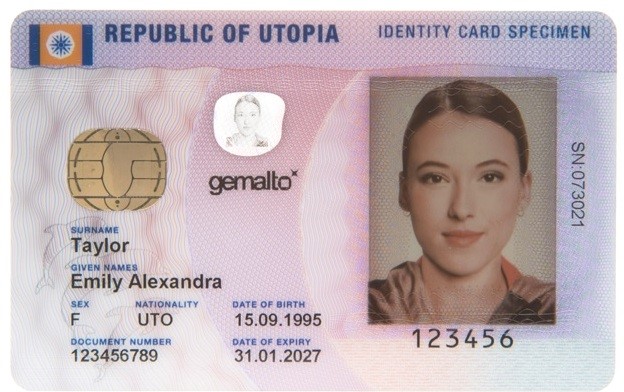Faced with the challenge to design and produce increasingly higher security credentials, jurisdictions find themselves assessing more criteria than ever before when it comes time to redesign their DL/ID. Once the REAL ID Act was passed, security best practices and federal credential standards raised the game. In order to elevate security, comply with new and existing standards, and combat potential threats and/or attacks, you have to choose the right card substrate that is up for the task.
If you’re looking to choose a new substrate for your DL/ID card, this list will guide you in understanding your options; highlighting two in particular that Gemalto believes to be the recommended standards: PET/PVC composite and Polycarbonate.

There are a few factors that will determine which substrate makes sense for your jurisdiction. We’ve laid out our top five considerations to evaluating PET/PVC, Polycarbonate, and Teslin.
1. Issuance: Central Issuance (CI) or Over the Counter (OTC)
For many ID programs, the first decision in the card design process is the decision of the issuance model.
If your jurisdiction is issuing from a central production facility with a CI model, you have three AAMVA approved options: PET/PVC composite, Polycarbonate, and Teslin. We recommend going with a Polycarbonate card body, as it offers the highest level of security in today’s market and houses the most security features coveted by law enforcement.
If it is required or preferred to issue and produce your credential in the field offices with an OTC model, you have two options: PET/PVC composite and Polycarbonate. Unlike the Polycarbonate card, PET/PVC uses retransfer printing for personalization. Polycarbonate on the other hand, requires the use of specialized laser engraving printers, making it a more expensive option than PET/PVC due to the cost of the OTC laser engravers.
It is also possible to use a hybrid model, meaning characteristics from both CI and OTC models are incorporated depending on the different jurisdictional objectives that must be met. For example, a Polycarbonate card can be a good substrate, even when the majority of cards are issued centrally, but an emergency issuance model is required to deal with immediate needs like an OTC printer.
Whichever model you move forward with, consider how you will maintain consistency across all of your documents. Minimizing variability between your licenses is key to designing a high quality credentials.
2. Photo Requirements: Color Photo or Black and White
Depending on your jurisdictional requirements or preferences, you will have to decide between a color photo or black and white photo for your new credential. If your state’s legislative requirements specify the use of a color photo, you have three options: PET/PVC composite, Teslin, or a high-security, cutting edge Color Laser Shield (CLS) Polycarbonate card.

If you opt for a black and white photo instead, going with a Polycarbonate body is a simple, highly secure solution, as laser engraving a black and white photo on a Polycarbonate card is a standard many jurisdictions choose.
Keep these options in mind as you go through this checklist, evaluating other variables against your photo requirements.
3. Security Features: Choose Features that combat your threats directly
The most secure document will use features, materials, and technologies that are inaccessible to the public, minimizing the risk for counterfeiting or alteration. If you want the strongest barrier of defense, choose the strongest security features on the market.
Different substrates house different security features, so identifying the ones that need to be prioritized is a critical consideration in your substrate selection process. If you have been following the blog series on redesigning your DL/ID, you will want to refer back to your threat assessment so you can choose security features that directly combat any imminent or future threats to your credential.
Consider features that can arm your card against forgery like an Optically Variable Device (OVD) or Color Floating Image, which we offer for both PET/PVC and Polycarbonate. Both PET/PVC and Polycarbonate cards offer a tamper-evident card body, but if you are looking to take it a step further, choose features that are equally tamper-evident, like a strong level one tactile or edge sealer security feature, which are only available for Polycarbonate cards. These easily identifiable level one security features cannot be altered or counterfeited.

4. Durability: Choose a durable substrate for the best ROI
Choosing a durable substrate, paired with the right security features will give you the highest return on your investment.
The goal is to choose a substrate that is highly resistant to change. Your credential will come into contact with environmental conditions and accidental or deliberate misuse. This can leave your credential susceptible to chips, tearing, or delamination. While Teslin is a viable option, we recommend PET/PVC or Polycarbonate as the most suitable options, as they offer a higher level of durability.
For example, if you are finding delamination or chips and tearing to be threats, both PET/PVC and Polycarbonate card bodies will offer you a strong defense. While PET/PVC does use adhesives, there will be clear signs on the card body if someone accidentally or deliberately delaminates, chips, or tears it. It also meets the market requirements of 8 years durability, making it an excellent substrate choice for fighting change. Polycarbonate, on the other hand, is formed by fusing together layers, guaranteeing the highest barrier of defense against delamination and chips and tearing. With a shelf-life of a minimum of 10 years durability, a Polycarbonate card is the most durable substrate on the market today.
5. Cost: Don’t consider the substrate price in insolation
When speaking about the cost of a specific substrate, it’s important to not consider the substrate price in isolation. The cost of the document, according to AAMVA, includes: “the fixed and variable costs associated with enrollment, manufacture, personalization, issuance, shipping, and the many administrative functions necessary to manage and secure these functions.” Evaluate the variables surrounding each substrate option before making a decision.
For example, a PET/PVC composite card body has a lower price point than a Polycarbonate card body, but there are additional fees involved as a result of the consumables (shipping and stock uptake) and administrative tasks necessary to manage and secure these functions. With a standard Polycarbonate card, the card body has a higher price point initially, but tends to be cheaper in full production than a PET/PVC, as no additional consumables are required.
There are many stakeholders involved: the issuers, law enforcement, citizens, etc., each with different preferences and priorities for your new credential. Weigh your fixed and variable costs with your stakeholder preferences for a more comprehensive cost analysis to help inform your substrate decision.

Your substrate of choice dictates the trajectory of your card design. From issuance requirements to personalization technologies, the variability in substrate production and materials presents an important opportunity to properly evaluate requirements and preferences prior to substrate selection. Redesigning your DL/ID is a challenging process, but having full confidence in your substrate selection will help set you up for success.
Make sure to follow our driver’s license blog series to tune into the next step in the card redesign process, guiding you through choosing the right security printing and features for your new credential.
Find out more about Gemalto’s driver’s license solutions here. Also, for more information on our take on substrate security, check out our Guide to Secure Driver’s License & ID Substrate blog.


